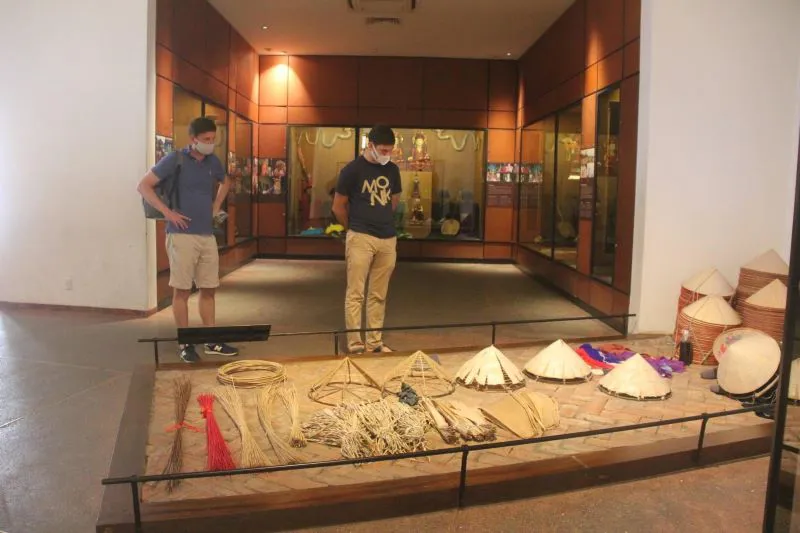Museum industry: changes in response to the Covid-19 pandemic
Diversifying activities attached with daily life and digitizing displayed items are among the resolutions for museums to overcome negative impacts of the Covid-19 pandemic.
An international conference titled “SDGs - Innovative Museum Transformations” held in Hanoi offered an opportunity for domestic museums to discuss about the obstacles to attract visitor during and after the pandemic.
The conference was co-organized by Vietnam Museum of Ethnology (VME), International Centre for Inclusive Cultural Leadership, AnantU (ICICL-AnantU) and UNESCO Chair on Inclusive Museums and Sustainable Heritage Development, India at VME on November 4.
| The conference took place in Hanoi and connected with speakers from afar via Zoom. Photo: VME |
Development barriers
According to Professor, Dr. Amareswar Gallea, Anant National University (India), UNESCO Chairman on Inclusive Museums and Sustainable Heritage Development, the current triangulation of Covid-19, climate crisis and vulnerability of ethnic groups in rural and remote areas has become a global challenge for museums.
One of the areas yet to be addressed is the rethinking of museums and UN Agenda 2030 and Sustainable Development Goals (SDGs).
“In this context, the next decade requires an accelerated pace of culture in development and rethinking museum anthropology,” he said.
The International Conference on “SDGs - Innovative Museum Transformations” is a timely action of Vietnam to call for experts in the field to sit down and discuss new directions of the industry’s development in the future.
Affirming that “museum’s activities must always be associated with contemporary life”, Professor, Dr. Nguyen Van Huy, Director of the Nguyen Van Huyen Museum, said: "Contemporary life is a ‘bridge’ that help connecting the community with the museums and vice versa. Exhibitions about daily life often touch the emotions of viewers, therefore, will attract a large number of visitors to the museums, locally and internationally.”
“This not only contributes to improving its social prestige, but also helps increase income of the museum,” he added.
| Speakers joined the conference from afar. Photo: Jenna Duong |
Besides, the application of technology into operation is also a key issue, deciding the survival of the museum in the new situation. “Digitalization in museum display in Vietnam is an inevitable trend,” said Dr. Phan Van Loi, Institute of Vietnamese Studies and Development Sciences.
However, according to Loi, if museums want to conduct digitization successfully, they first need to do a good job of classifying artifacts – a hard work for quite a few local museums. At the same time, the application of science and technology also requires a large amount of funding, presenting a challenge for local museums in particular and the whole museum industry in general.
Making changes to adapt the new situation
As for Hanoi, the fourth wave of the Covid-19 pandemic has led to the suspension of museum operation and caused huge losses to the tourism industry.
| Vietnam Fine Arts Museum applied technology 4.0 to help online visitors exploring regularly displayed artworks. Photo: VFA |
The renovation of museums is one of many activities that Hanoi has been conducting to warm up the local travel sector.
While waiting for the authorization to reopen services, many museums have applied digital solutions to offer online tours for visitors.
According to Deputy Director of the Vietnam National Museum of Nature Vu Van Lien, the museum has built a virtual museum with abundant information to enrich visitors’ knowledge.
“Once the Covid-19 pandemic is controlled, we will offer interesting offline activities to attract young visitors. Some activities of ours such as making insect specimens, miniatures of dinosaur fossils, as well as sea creatures and animal masks may not only help children to learn more about the natural world but also create a habit of visiting museums from an early age among them,” Lien told The Hanoi Times.
| Visitor to Vietnam Museum of Ethnology. Photo: VME |
Meanwhile, the Vietnam Fine Arts Museum (VFA) has recently launched the iMuseum VFA app that is available in various languages of Vietnamese, English, French, Chinese, Japanese, Korean, Spanish, Italian and Germany.
Running on both Android and iOS platforms and using QR code scanning and iBeacon technology, it provides high-quality audio, text, and photos, helping users visit the museum online and explore regularly displayed artworks.
In order to maintain the connection with visitors during and after the pandemic, Vietnam National Museum of History has been gathering documents to digitize all national treasures preserved here. It is the first museum in Vietnam to apply 3D technology since 2013 and now it is digitizing all of the artifacts.
In can be seen that in the rapid development of technology 4.0 and the complicated evolution of the Covid-19 pandemic, museums need to renovate themselves to attract more visitors.

.jpg)
.jpg)
.jpg)










